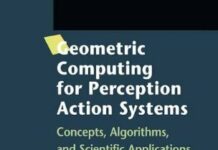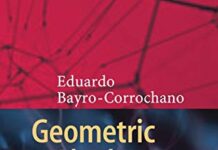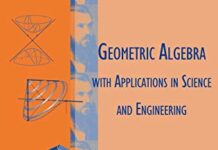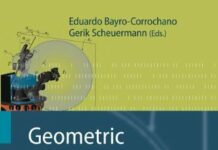
Ebook Info
- Published: 2010
- Number of pages: 622 pages
- Format: PDF
- File Size: 20.52 MB
- Authors: Eduardo Bayro Corrochano
Description
This book offers a gentle introduction to Clifford geometric algebra, an advanced mathematical framework, for applications in perception action systems. Part I, is written in an accessible way allowing readers to easily grasp the mathematical system of Clifford algebra. Part II presents related topics. While Part 3 features practical applications for Computer Vision, Robotics, Image Processing and Neural Computing.Topics and Features include: theory and application of the quaternion Fourier and wavelet transforms, thorough discussion on geometric computing under uncertainty, an entire chapter devoted to the useful conformal geometric algebra, presents examples and hints for the use of public domain computer programs for geometric algebra.The modern framework for geometric computing highlighted will be of great use for communities working on image processing, computer vision, artificial intelligence, neural networks, neuroscience, robotics, control engineering, human and robot interfaces, haptics and humanoids.
User’s Reviews
Product description Review From the reviews:“This book presents the theory and engineering applications of geometric algebra, a very powerful mathematical system. … The results highlight that geometric algebra is a mathematical tool that can be used very advantageously in many engineering scenarios. … has a real potential to convince a big audience of the benefits of using geometric algebra in engineering applications, and I hope that it will be successful.” (Dietmar Hildenbrand, IAPR Newsletter, Vol. 33 (3), July, 2011)“The theory and applications of geometric algebra (Clifford algebra), an advanced mathematical language, are addressed in this book. … The book is aimed at a graduate-level audience … . it can also be well suited for teaching a course or for self-study at the postgraduate level. Each chapter is accompanied by numerous examples and figures … . also be useful to scientists and engineers who are working in various areas related to the development and building of intelligent machines. I really enjoyed reading it.” (George K. Adam, ACM Computing Reviews, October, 2010)“The subject of this interesting book is the application of geometric algebra to image processing, computer vision, neurocomputing and robotics. … A notation table, a list of useful formulas, a bibliography and an index conclude the book. The book is well structured, rich in data, and it contains many exercises; it is aimed at graduate students.” (Patrizio Frosini, Zentralblatt MATH, Vol. 1211, 2011) From the Back Cover Geometric algebra provides a rich and general mathematical framework for the development of solutions, concepts and computer algorithms without losing geometric insight into the problem in question. Many current mathematical subjects can be treated in an unified manner without abandoning the mathematical system of geometric algebra, such as; multilinear algebra, projective and affine geometry, calculus on manifolds, Riemann geometry, the representation of Lie algebras and Lie groups using bivector algebras, and conformal geometry.Geometric Computing for Wavelet Transforms, Robot Vision, Learning, Control and Action presents a unified mathematical treatment of diverse problems in artificial intelligence and associated fields using Clifford, or geometric, algebra. By treating a wide spectrum of problems in a common language, this book offers both new insights and new solutions that should be useful to scientists, and engineers working in different areas related with the development and building of intelligent machines. Each chapter is written in accessible terms and is accompanied by numerous examples and figures. These features, together with a complementary appendix on Clifford algebras, serve to clarify the theory and fundamental aspects of the application of geometric algebra to problems in image processing and related fields.Topics and features:Introduces nonspecialists to geometric algebra and, by examples, encourages readers to learn to compute using geometric entities and geometric formulationsPresents a thorough discussion of several tasks for image processing, pattern recognition, computer vision, robotics, neurocomputing, cognitive systems and engineering using the geometric algebra frameworkProvides exercises and hints for the development of future computer software packages for extensive calculations in geometric algebraDescribes applications of geometric algebra to other related areas, such as graphics engineering, aeronautics, mechatronics, biomechanics and quantum computingFeatures the computing frameworks of the linear model n-dimensional affine plane and the nonlinear model of Euclidean space known as the horosphere, and addresses the relationships of these models to conformal, affine, and projective geometriesIncludes a thorough study of all existing Clifford Fourier transforms and Clifford wavelet transforms, using the phase concept to show how to disentangle symmetries useful for scene analysis and medical image processingThe book is an essential resource for computer scientists, applied physicists, AI researchers and mechanical and electrical engineers. It clarifies and demonstrates the importance of geometric computing for building autonomous systems and pushing forward advances in cognitive systems research.Prof. Dr. Eng. Eduardo Bayro-Corrochano is a Full Professor of Geometric Computing at Cinvestav, Mexico. His published books include Handbook of Geometric Computing.
Reviews from Amazon users which were colected at the time this book was published on the website:
⭐This is a great material for any computer scientist. Good material for students and professors who want and introduction or reinforcement from their knowledge
Keywords
Free Download Geometric Computing: for Wavelet Transforms, Robot Vision, Learning, Control and Action in PDF format
Geometric Computing: for Wavelet Transforms, Robot Vision, Learning, Control and Action PDF Free Download
Download Geometric Computing: for Wavelet Transforms, Robot Vision, Learning, Control and Action 2010 PDF Free
Geometric Computing: for Wavelet Transforms, Robot Vision, Learning, Control and Action 2010 PDF Free Download
Download Geometric Computing: for Wavelet Transforms, Robot Vision, Learning, Control and Action PDF
Free Download Ebook Geometric Computing: for Wavelet Transforms, Robot Vision, Learning, Control and Action



